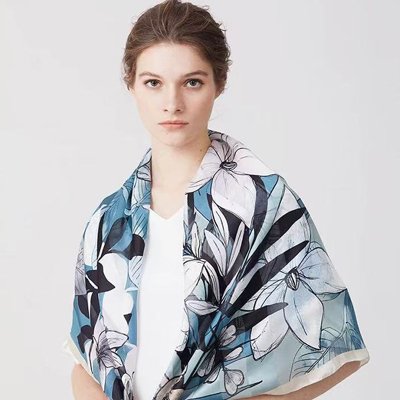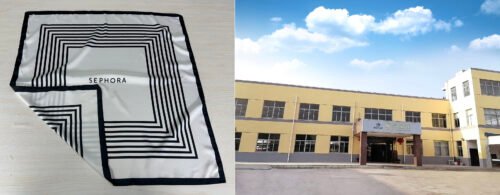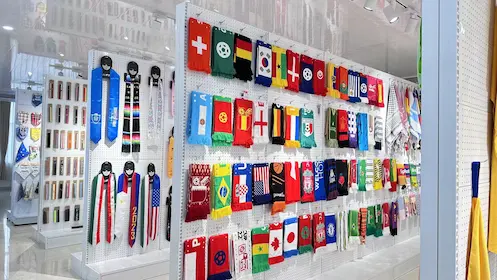目次
トグルThe difference between silk scarves and satin scarves
材料
Silk scarves: Made from natural silk, such as mulberry silk, tussah silk, etc., these silks are spun by silkworms and are a natural protein fiber

Satin scarves: usually made of artificial fibers such as polyester or nylon, and some are mixed with fibers such as cotton and linen.

Appearance and texture
Silk scarf: soft and natural luster, as warm as pearls, with unique light-absorbing properties, looks smooth and not mirror-like
Satin scarf: The luster is relatively bright, somewhat similar to mirror reflection, looks dazzling, and the overall texture is relatively tough.
Feel and touch
Silk scarf: It feels soft and delicate, silky and flowing, very skin-friendly when in contact with the skin, extremely comfortable, easy to wrinkle after being pinched by hand, but can quickly return to its original shape.
Satin scarf: Although it can also be soft, it feels a little stiff and not smooth enough compared to silk, and it is not easy to wrinkle after being pinched.
Production process
Silk scarves: The production process is complicated, from the breeding of silkworms, the collection of cocoons, to the extraction and processing of silk, etc., it requires many tedious steps and the cost is relatively high.
Satin scarf: Made from man-made or synthetic fibers, the production process is relatively simple and the cost is low.
Performance characteristics
Silk scarf: It has good air permeability and moisture absorption, can absorb sweat and moisture on the skin surface, keep the skin dry, and also has certain sun protection properties, which can block some ultraviolet rays.
Satin scarf: It has poor air permeability and is not as hygroscopic as silk, but it has good wear resistance and wrinkle resistance, is not easy to deform, and is easy to care for.
satin or silk scarf,which is better
From the perspective of use, the “good or bad” of silk scarves and satin scarves depends on the specific scene and needs. Both have their own advantages, and there is no absolute distinction between good and bad.
1. Daily commuting/long-term wear: Silk scarves are more comfortable
Breathability and skin-friendliness: Silk is a natural protein fiber with excellent breathability. It can quickly absorb sweat and moisture from the skin surface. It does not cause sweat when worn in summer. It is soft and smooth when it is close to the skin. It will not cause stuffiness or itching when in contact with the skin for a long time. It is especially suitable for people in hot weather or with sensitive necks.
Functional adaptation: In air-conditioned rooms, silk has a mild warmth retention property (not too thick), which can resist cold air without causing sweat and stickiness on the neck due to poor air permeability. It is suitable for switching from high temperature outdoors to indoor air-conditioned rooms.
2. Outdoor exposure/frequent activities: Satin scarves are more durable
Abrasion resistance and wrinkle resistance: Satin is made of synthetic materials such as polyester fibers. The material is more rigid and wrinkle-resistant. It is not easy to wrinkle after folding or kneading. It is not easy to deform when running outdoors or in the wind. It is also more abrasion-resistant than silk (silk fibers are delicate and easily snagged and scratched).
Easy to care for: Satin scarves are not afraid of water or sweat stains (silk turns yellow easily when exposed to sweat). They can be machine washed directly after getting dirty, and can be restored to flatness after drying without ironing. They are suitable for travel, shopping, and other situations that require “easy” care.
3. Requirement for “texture and experience”: Silk scarves are better
User experience: The drape and flow of silk are irreplaceable by satin. When tied around the neck or draped over the shoulders, it falls naturally with the movement, feels smooth, and can enhance the exquisiteness of wearing; and silk has certain “skin care” properties, and long-term wearing is more friendly to the neck skin (especially in dry seasons, it can reduce peeling caused by friction).
Scene adaptation: If used to match elegant styles such as shirts and dresses, the warm luster of silk can enhance the overall texture, while the luster of satin is more “plastic” and may look cheap.
まとめ
It is more reasonable to choose according to needs
Choose silk: suitable for those who pursue comfort, skin-friendly, texture, and relatively mild scenes (such as office, indoor activities, exquisite daily life), and are willing to accept slightly higher care costs for the “experience” (hand washing is required, avoid exposure to the sun).
Choose satin: suitable for those who need to be durable, wrinkle-resistant, easy to care for, and the scenes are more outdoor and the amount of activities is large (such as travel, shopping, sports style matching), and pay more attention to “practicality” and cost-effectiveness.
よくある質問
Which is better: silk or satin scarf?
Silk is better for quality and durability, while satin is better for affordability.
Which is better quality: silk or satin?
Silk has better quality – it’s a natural fiber that’s more durable and breathable.
What is the best fabric for scarves?
Silk is the best overall – it’s natural, breathable, and long-lasting.
Is silk or satin better for your head?
Silk is better for your head – it’s gentler on skin and hair, and more breathable.



